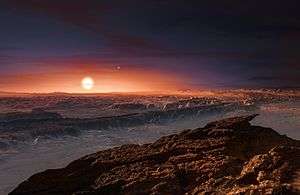Rosetta (spacecraft)
|
Artist's illustration of Rosetta | |||||||||||||||||||||||||
| Mission type | Comet orbiter/lander | ||||||||||||||||||||||||
|---|---|---|---|---|---|---|---|---|---|---|---|---|---|---|---|---|---|---|---|---|---|---|---|---|---|
| Operator | ESA | ||||||||||||||||||||||||
| COSPAR ID | 2004-006A | ||||||||||||||||||||||||
| SATCAT № | 28169 | ||||||||||||||||||||||||
| Website |
esa | ||||||||||||||||||||||||
| Mission duration | Final: 12 years, 6 months, 28 days | ||||||||||||||||||||||||
| Spacecraft properties | |||||||||||||||||||||||||
| Manufacturer | Astrium | ||||||||||||||||||||||||
| Launch mass |
Orbiter: 2,900 kg (6,400 lb) Lander: 100 kg (220 lb) | ||||||||||||||||||||||||
| Dry mass | Orbiter: 1,230 kg (2,710 lb) | ||||||||||||||||||||||||
| Payload mass |
Orbiter: 165 kg (364 lb) Lander: 27 kg (60 lb) | ||||||||||||||||||||||||
| Dimensions | 2.8 × 2.1 × 2 m (9.2 × 6.9 × 6.6 ft) | ||||||||||||||||||||||||
| Power | 850 watts at 3.4 AU[1] | ||||||||||||||||||||||||
| Start of mission | |||||||||||||||||||||||||
| Launch date | 2 March 2004, 07:17:51 UTC[2] | ||||||||||||||||||||||||
| Rocket | Ariane 5G+ V-158 | ||||||||||||||||||||||||
| Launch site | Kourou ELA-3 | ||||||||||||||||||||||||
| Contractor | Arianespace | ||||||||||||||||||||||||
| End of mission | |||||||||||||||||||||||||
| Disposal | Deorbited | ||||||||||||||||||||||||
| Last contact | 30 September 2016, 10:39:28 UTC SCET | ||||||||||||||||||||||||
| Landing site |
Sais, Ma'at region[3] 2 years, 55 days of operations at the comet | ||||||||||||||||||||||||
| Flyby of Mars | |||||||||||||||||||||||||
| Closest approach | 25 February 2007 | ||||||||||||||||||||||||
| Distance | 250 km (160 mi) | ||||||||||||||||||||||||
| Flyby of 2867 Šteins | |||||||||||||||||||||||||
| Closest approach | 5 September 2008 | ||||||||||||||||||||||||
| Distance | 800 km (500 mi) | ||||||||||||||||||||||||
| Flyby of 21 Lutetia | |||||||||||||||||||||||||
| Closest approach | 10 July 2010 | ||||||||||||||||||||||||
| Distance | 3,162 km (1,965 mi) | ||||||||||||||||||||||||
| 67P/Churyumov–Gerasimenko orbiter | |||||||||||||||||||||||||
| Orbital insertion | 6 August 2014, 09:06 UTC[4] | ||||||||||||||||||||||||
| Orbit parameters | |||||||||||||||||||||||||
| Periapsis | 29 km (18 mi)[5] | ||||||||||||||||||||||||
| Transponders | |||||||||||||||||||||||||
| Band |
S band (low gain antenna) X band (high gain antenna) | ||||||||||||||||||||||||
| Bandwidth |
from 7.8 bit/s (S band)[6] up to 91 kbit/s (X band)[7] | ||||||||||||||||||||||||
| |||||||||||||||||||||||||
 Rosetta mission insignia | |||||||||||||||||||||||||
Rosetta was a space probe built by the European Space Agency launched on 2 March 2004. Along with Philae, its lander module, Rosetta performed a detailed study of comet 67P/Churyumov–Gerasimenko (67P).[8][9] During its journey to the comet, the spacecraft flew by Mars and the asteroids 21 Lutetia and 2867 Šteins.[10][11][12]
On 6 August 2014, the spacecraft reached the comet and performed a series of manoeuvres to be captured in its orbit. On 12 November, its lander module Philae performed the first successful landing on a comet,[13] though its battery power ran out two days later.[14] Communications with Philae were briefly restored in June and July 2015, but due to diminishing solar power, Rosetta's communications module with the lander was turned off on 27 July 2016.[15] On 30 September 2016, the Rosetta spacecraft ended its mission by landing on the comet in its Ma'at region.[16][17]
The probe is named after the Rosetta Stone, a stele of Egyptian origin featuring a decree in three scripts. The lander is named after the Philae obelisk, which bears a bilingual Greek and Egyptian hieroglyphic inscription.
Mission overview
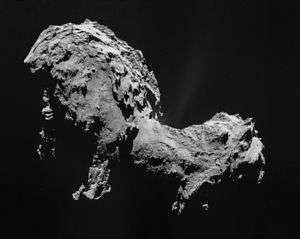
Rosetta was launched on 2 March 2004 from the Guiana Space Centre in French Guiana on an Ariane 5 rocket and reached Comet Churyumov–Gerasimenko on 6 August 2014,[18] becoming the first spacecraft to orbit a comet.[19][20][21] (Previous missions had conducted successful flybys of seven other comets.)[22] It was one of ESA's Horizon 2000 cornerstone missions.[23] The spacecraft consisted of the Rosetta orbiter, which featured 12 instruments, and the Philae lander, with nine additional instruments.[24] The Rosetta mission orbited Comet Churyumov–Gerasimenko for 17 months and was designed to complete the most detailed study of a comet ever attempted. The spacecraft was controlled from the European Space Operations Centre (ESOC), in Darmstadt, Germany.[25] The planning for the operation of the scientific payload, together with the data retrieval, calibration, archiving and distribution, was performed from the European Space Astronomy Centre (ESAC), in Villanueva de la Cañada, near Madrid, Spain.[26] It has been estimated that in the decade preceding 2014, some 2,000 people assisted in the mission in some capacity.[27]
In 2007, Rosetta made a Mars gravity assist (flyby) on its way to Comet Churyumov–Gerasimenko.[28] The spacecraft also performed two asteroid flybys.[29] The craft completed its flyby of asteroid 2867 Šteins in September 2008 and of 21 Lutetia in July 2010.[30] Later, on 20 January 2014, Rosetta was taken out of a 31-month hibernation mode as it approached Comet Churyumov–Gerasimenko.[31][32]
Rosetta's Philae lander successfully made the first soft landing on a comet nucleus when it touched down on Comet Churyumov–Gerasimenko on 12 November 2014.[33][34][35] On 5 September 2016, ESA announced that the lander was discovered by the narrow-angle camera aboard Rosetta as the orbiter made a low, 2.7 km (1.7 mi) pass over the comet. The lander sits on its side wedged into a dark crevice of the comet, explaining the lack of electrical power to establish proper communication with the orbiter.[36]
History
Background
During the 1986 approach of Halley's Comet, international space probes were sent to explore the comet, most prominent among them being ESA's Giotto.[37] After the probes returned valuable scientific information, it became obvious that follow-ons were needed that would shed more light on cometary composition and answer new questions.[38]
Both ESA and NASA started cooperatively developing new probes. The NASA project was the Comet Rendezvous Asteroid Flyby (CRAF) mission.[39] The ESA project was the follow-on Comet Nucleus Sample Return (CNSR) mission.[40] Both missions were to share the Mariner Mark II spacecraft design, thus minimising costs. In 1992, after NASA cancelled CRAF due to budgetary limitations, ESA decided to develop a CRAF-style project on its own.[41] By 1993 it was evident that the ambitious sample return mission was infeasible with the existing ESA budget, so the mission was redesigned and subsequently approved by the ESA, with the final flight plan resembling the cancelled CRAF mission: an asteroid flyby followed by a comet rendezvous with in-situ examination, including a lander.[41] After the spacecraft launch, Gerhard Schwehm was named mission manager; he retired in March 2014.[27]
Naming
The probe is named after the Rosetta Stone, a stele of Egyptian origin featuring a decree in three scripts. The lander is named after the Philae obelisk, which bears a bilingual Greek and Egyptian hieroglyphic inscription. A comparison of its hieroglyphs with those on the Rosetta Stone catalysed the deciphering of the Egyptian writing system. Similarly, it is hoped that these spacecraft will result in better understanding of comets and the early Solar System.[42][43] In a more direct analogy to its namesake, the Rosetta spacecraft also carries a micro-etched nickel alloy Rosetta disc donated by the Long Now Foundation inscribed with 13,000 pages of text in 1,200 languages.[44]
Mission firsts
The Rosetta mission achieved many historic firsts.[45]
On its way to comet 67P, Rosetta passed through the main asteroid belt, and made the first European close encounter with several of these primitive objects. Rosetta was the first spacecraft to fly close to Jupiter's orbit using solar cells as its main power source.[46]
Rosetta was the first spacecraft to orbit a comet nucleus,[47] and was the first spacecraft to fly alongside a comet as it headed towards the inner Solar System. It became the first spacecraft to examine at close proximity the activity of a frozen comet as it is warmed by the Sun. Shortly after its arrival at 67P, the Rosetta orbiter dispatched the Philae lander for the first controlled touchdown on a comet nucleus. The robotic lander's instruments obtained the first images from a comet's surface and made the first in situ analysis of its composition.
Design and construction
The Rosetta bus is a 2.8 × 2.1 × 2.0 m (9.2 × 6.9 × 6.6 ft) central frame and aluminium honeycomb platform. Its total mass is approximately 3,000 kg (6,600 lb), which includes the 100 kg (220 lb) Philae lander and 165 kg (364 lb) of science instruments.[48] The Payload Support Module is mounted on top of the spacecraft and houses the scientific instruments, while the Bus Support Module is on the bottom and contains spacecraft support subsystems. Heaters placed around the spacecraft keep its systems warm while it is distant from the Sun. Rosetta's communications suite includes a 2.2 m (7.2 ft) steerable high-gain parabolic dish antenna, a 0.8 m (2.6 ft) fixed-position medium-gain antenna, and two omnidirectional low-gain antennas.[49]
Electrical power for the spacecraft comes from two solar arrays totalling 64 square metres (690 sq ft).[50] Each solar array is subdivided into five solar panels, with each panel being 2.25 × 2.736 m (7.38 × 8.98 ft). The individual solar cells are made of silicon, 200 μm thick, and 61.95 × 37.75 mm (2.44 × 1.49 in).[51] The solar arrays generate a maximum of approximately 1,500 watts at perihelion,[51] a minimum of 400 watts in hibernation mode at 5.2 AU, and 850 watts when comet operations begin at 3.4 AU.[49] Spacecraft power is controlled by a redundant Terma power module also used in the Mars Express spacecraft,[52][53] and is stored in four 10-A·h NiCd batteries supplying 28 volts to the bus.[49]
Main propulsion comprises 24 paired bipropellant 10 N thrusters,[50] with four pairs of thrusters being used for delta-v burns. The spacecraft carried 1,719.1 kg (3,790 lb) of propellant at launch: 659.6 kg (1,454 lb) of monomethylhydrazine fuel and 1,059.5 kg (2,336 lb) of dinitrogen tetroxide oxidiser, contained in two 1,108-litre (244 imp gal; 293 US gal) grade 5 titanium alloy tanks and providing delta-v of at least 2,300 metres per second (7,500 ft/s) over the course of the mission. Propellant pressurisation is provided by two 68-litre (15 imp gal; 18 US gal) high-pressure helium tanks.[54]
Rosetta was built in a clean room according to COSPAR rules, but "sterilisation [was] generally not crucial since comets are usually regarded as objects where you can find prebiotic molecules, that is, molecules that are precursors of life, but not living microorganisms", according to Gerhard Schwehm, Rosetta's project scientist.[55] The total cost of the mission is about €1.3 billion (US$1.8 billion).[56]
Launch

Rosetta was set to be launched on 12 January 2003 to rendezvous with the comet 46P/Wirtanen in 2011.[38] This plan was abandoned after the failure of an Ariane 5 carrier rocket during Hot Bird 7's launch on 11 December 2002, grounding it until the cause of the failure could be determined.[57] In May 2003, a new plan was formed to target the comet 67P/Churyumov–Gerasimenko, with a revised launch date of 26 February 2004 and comet rendezvous in 2014.[58][59] The larger mass and the resulting increased impact velocity made modification of the landing gear necessary.[60]
After two scrubbed launch attempts, Rosetta was launched on 2 March 2004 at 07:17 UTC from the Guiana Space Centre in French Guiana.[2] Aside from the changes made to launch time and target, the mission profile remained almost identical. Both co-discoverers of the comet, Klim Churyumov and Svetlana Gerasimenko, were present at the spaceport during the launch.[61][62]
Deep space manoeuvres
To achieve the required velocity to rendezvous with 67P, Rosetta used gravity assist manoeuvres to accelerate throughout the inner Solar System.[63] The comet's orbit was known before Rosetta's launch, from ground-based measurements, to an accuracy of approximately 100 km (62 mi). Information gathered by the onboard cameras beginning at a distance of 24 million kilometres (15,000,000 mi) were processed at ESA's Operation Centre to refine the position of the comet in its orbit to a few kilometres.
The first Earth flyby was on 4 March 2005.[64]
On 25 February 2007, the craft was scheduled for a low-altitude flyby of Mars, to correct the trajectory. This was not without risk, as the estimated altitude of the flyby was a mere 250 kilometres (160 mi).[65] During that encounter, the solar panels could not be used since the craft was in the planet's shadow, where it would not receive any solar light for 15 minutes, causing a dangerous shortage of power. The craft was therefore put into standby mode, with no possibility to communicate, flying on batteries that were originally not designed for this task.[66] This Mars manoeuvre was therefore nicknamed "The Billion Euro Gamble".[67] The flyby was successful, with Rosetta even returning detailed images of the surface and atmosphere of the planet, and the mission continued as planned.[10][28]
The second Earth flyby was on 13 November 2007 at a distance of 5,700 km (3,500 mi).[68][69] In observations made on 7 and 8 November, Rosetta was briefly mistaken for a near-Earth asteroid about 20 m (66 ft) in diameter by an astronomer of the Catalina Sky Survey and was given the provisional designation 2007 VN84.[70] Calculations showed that it would pass very close to Earth, which led to speculation that it could impact Earth.[71] However, astronomer Denis Denisenko recognised that the trajectory matched that of Rosetta, which the Minor Planet Center confirmed in an editorial release on 9 November.[72][73]
The spacecraft performed a close flyby of asteroid 2867 Šteins on 5 September 2008. Its onboard cameras were used to fine-tune the trajectory, achieving a minimum separation of less than 800 km (500 mi). Onboard instruments measured the asteroid from 4 August to 10 September. Maximum relative speed between the two objects during the flyby was 8.6 km/s (19,000 mph; 31,000 km/h).[74]
Rosetta's third and final flyby of Earth happened on 12 November 2009.[75]
On 10 July 2010, Rosetta flew by 21 Lutetia, a large main-belt asteroid, at a minimum distance of 3,168±7.5 km (1,969±4.7 mi) at a velocity of 15 kilometres per second (9.3 mi/s).[12] The flyby provided images of up to 60 metres (200 ft) per pixel resolution and covered about 50% of the surface, mostly in the northern hemisphere.[30][76] The 462 images were obtained in 21 narrow- and broad-band filters extending from 0.24 to 1 μm.[30] Lutetia was also observed by the visible–near-infrared imaging spectrometer VIRTIS, and measurements of the magnetic field and plasma environment were taken as well.[30][76]
In May 2014, Rosetta began a series of eight burns. These reduced the relative velocity between the spacecraft and 67P from 775 m/s (2,540 ft/s) to 7.9 m/s (26 ft/s).[18]
Reaction control system problems
In 2006, Rosetta suffered a leak in its reaction control system (RCS).[63] The system, which consists of 24 bipropellant 10-newton thrusters,[18] was responsible for fine tuning the trajectory of Rosetta throughout its journey. The RCS operated at a lower pressure than designed due to the leak. While this may have caused the propellants to mix incompletely and burn 'dirtier' and less efficiently, ESA engineers were confident that the spacecraft would have sufficient fuel reserves to allow for the successful completion of the mission.[77]
Rosetta's reaction wheels also showed higher than expected vibration, though testing revealed the system could be operated more efficiently resulting in less wear on the wheels. Before hibernation, two of the spacecraft's four reaction wheels began exhibiting "noise". Engineers turned on three of the wheels after the spacecraft awoke, including one of the bad wheels. The other improperly functioning wheel was held in reserve. Additionally, new software was uploaded which would allow Rosetta to function with only two active reaction wheels if necessary.[63][78]
Orbit around 67P
In August 2014, Rosetta rendezvoused with the comet 67P/Churyumov–Gerasimenko (67P) and commenced a series of manoeuvres that took it on two successive triangular paths, averaging 100 and 50 kilometres (62 and 31 mi) from the nucleus, whose segments are hyperbolic escape trajectories alternating with thruster burns.[19][20] After closing to within about 30 km (19 mi) from the comet on 10 September, the spacecraft entered actual orbit about it.[19][20][21]
The surface layout of 67P was unknown before Rosetta's arrival. The orbiter mapped the comet in anticipation of detaching its lander.[79] By 25 August 2014, five potential landing sites had been determined.[80] On 15 September 2014, ESA announced Site J, named Agilkia in honour of Agilkia Island by an ESA public contest and located on the "head" of the comet,[81] as the lander's destination.[82]
Philae lander
.jpg)
Philae detached from Rosetta on 12 November 2014 at 08:35 UTC, and approached 67P at a relative speed of about 1 m/s (3.6 km/h; 2.2 mph).[83] It initially landed on 67P at 15:33 UTC, but bounced twice, coming to rest at 17:33 UTC.[13][84] Confirmation of contact with 67P reached Earth at 16:03 UTC.[85]
On contact with the surface, two harpoons were to be fired into the comet to prevent the lander from bouncing off as the comet's escape velocity is only around 1 m/s (3.6 km/h; 2.2 mph).[86] Analysis of telemetry indicated that the surface at the initial touchdown site is relatively soft, covered with a layer of granular material about 0.82 feet (0.25 meters) deep,[87] and that the harpoons had not fired upon landing. After landing on the comet, Philae had been scheduled to commence its science mission, which included:
- Characterisation of the nucleus
- Determination of the chemical compounds present, including amino acid enantiomers[88]
- Study of comet activities and developments over time
Philae landed oddly, in the shadow of a nearby cliff[89] and canted at an angle of around 30 degrees. This made it unable to adequately collect solar power, and it lost contact with Rosetta when its batteries ran out after two days, well before much of the planned science objectives could be attempted.[14] Contact was briefly and intermittently reestablished several months later at various times between 13 June and 9 July, before contact was lost once again. There was no communication afterwards,[90] and the transmitter to communicate with Philae was switched off in July 2016 to reduce power consumption of the probe.[91] The precise location of the lander was discovered in September 2016 when Rosetta came closer to the comet and took high-resolution pictures of its surface.[89] Knowing its exact location provides information needed to put Philae's two days of science into proper context.[89]
Notable results
Researchers expect the study of data gathered will continue for decades to come. One of the first discoveries was that the magnetic field of 67P oscillated at 40–50 millihertz. Scientists modified the signal by speeding it up 10,000 times so that people could hear a rendition of it. Although it is a natural phenomenon, it has been described as a "song"[92] and has been compared to Continuum for harpsichord by György Ligeti.[93] However, results from Philae's landing show that the comet's nucleus has no magnetic field, and that the field originally detected by Rosetta is likely caused by the solar wind.[94][95]
The isotopic signature of water vapour from comet 67P, as determined by the Rosetta spacecraft, is substantially different from that found on Earth. That is, the ratio of deuterium to hydrogen in the water from the comet was determined to be three times that found for terrestrial water. This makes it very unlikely that water found on Earth came from comets such as comet 67P, according to the scientists.[96][97][98] On 22 January 2015, NASA reported that, between June and August 2014, the rate at which water vapor was released by the comet increased up to tenfold.[99]
On 2 June 2015, NASA reported that the ALICE spectrograph on Rosetta determined that electrons within 1 km (0.6 mi) above the comet nucleus — produced from photoionization of water molecules by solar radiation, and not photons from the Sun as thought earlier — are responsible for the degradation of water and carbon dioxide molecules released from the comet nucleus into its coma.[100][101]
End of mission
As the orbit of comet 67P took it farther from the Sun, the amount of sunlight reaching Rosetta's solar panels decreased. While it would have been possible to put Rosetta into a second hibernation phase during the comet's aphelion, there was no assurance that enough power would be available to run the spacecraft's heaters to keep it from freezing. In order to guarantee a maximum science return, mission managers made the decision to instead guide Rosetta down to the comet's surface and end the mission on impact, gathering photographs and instrument readings along the way.[102] On 23 June 2015, at the same time as a mission extension was confirmed, ESA announced that end of mission would occur at the end of September 2016 after two years of operations at the comet.[103]
Rosetta began a 19 km (12 mi) descent with a 208-second thruster burn executed on 29 September 2016 at approximately 20:50 UTC.[104][105][106] Its trajectory targeted a site in the Ma'at region near an area of dust- and gas-producing active pits.[107]
Impact on the comet's surface occurred 14.5 hours after its descent manoeuvre; the final data packet from Rosetta was transmitted at 10:39:28.895 UTC (SCET) by the OSIRIS instrument and was received at the European Space Operations Centre in Darmstadt, Germany, at 11:19:36.541 UTC.[104][105][108] The spacecraft's estimated speed at the time of impact was 3.2 km/h (2.0 mph; 89 cm/s),[17] and its touchdown location, named Sais by the operations team after the Rosetta Stone's original temple home, is believed to be only 40 m (130 ft) off-target.[107] The final image transmitted by the spacecraft of the comet was taken by its OSIRIS instrument at an altitude of 20 m (66 ft) about 10 seconds before impact, showing an area 0.96 m (3.1 ft) across.[107] Rosetta's computer included commands to send it into safe mode upon detecting that it had hit the comet's surface, turning off its radio transmitter and rendering it inert in accordance with International Telecommunication Union rules.[106]
Instruments
Nucleus
The investigation of the nucleus is done by three optical spectrometers, one microwave radio antenna and one radar:
- ALICE (an ultraviolet imaging spectrograph). The ultraviolet spectrograph will search for and quantify the noble gas content in the comet nucleus, from which the temperature during the comet creation could be estimated. The detection is done by an array of potassium bromide and caesium iodide photocathodes. The 3.1 kg (6.8 lb) instrument uses 2.9 watts and was produced in the USA, and an improved version is used in the New Horizons spacecraft. It operates in the extreme and far ultraviolet spectrum, from 700–2,050 Å (70–205 nm).[109][110]
- OSIRIS (Optical, Spectroscopic, and Infrared Remote Imaging System). The camera system has a narrow-angle lens (700 mm) and a wide-angle lens (140 mm), with a 2048×2048 pixel CCD chip. The instrument was constructed in Germany.[111]
- VIRTIS (Visible and Infrared Thermal Imaging Spectrometer). The Visible and IR spectrometer is able to make pictures of the nucleus in the IR and also search for IR spectra of molecules in the coma. The detection is done by a mercury cadmium telluride array for IR and with a CCD chip for the visible wavelength range. The instrument was produced in Italy, and improved versions were used for Dawn and Venus Express.[112]
- MIRO (Microwave Instrument for the Rosetta Orbiter). The abundance and temperature of volatile substances like water, ammonia and carbon dioxide can be detected by MIRO via their microwave emissions. The 30 cm (12 in) radio antenna was constructed in Germany, while the rest of the 18.5 kg (41 lb) instrument was provided by the USA.
- CONSERT (Comet Nucleus Sounding Experiment by Radiowave Transmission). The CONSERT experiment will provide information about the deep interior of the comet using a radar. The radar will perform tomography of the nucleus by measuring electromagnetic wave propagation between the Philae lander and the Rosetta orbiter through the comet nucleus. This allows it to determine the comet's internal structure and deduce information on its composition. The electronics were developed by France and both antennas were constructed in Germany.[113]
- RSI (Radio Science Investigation). RSI makes use of the probe's communication system for physical investigation of the nucleus and the inner coma of the comet.[114]
Gas and particles
- ROSINA (Rosetta Orbiter Spectrometer for Ion and Neutral Analysis). The instrument consists of a double-focus magnetic mass spectrometer (DFMS) and a reflectron type time of flight mass spectrometer (RTOF). The DFMS has a high resolution (can resolve N2 from CO) for molecules up to 300 amu. The RTOF is highly sensitive for neutral molecules and for ions.[115] ROSINA was developed at the University of Bern in Switzerland.
- MIDAS (Micro-Imaging Dust Analysis System). The high-resolution atomic force microscope will investigate several physical aspects of the dust particles which are deposited on a silicon plate.[116]
- COSIMA (Cometary Secondary Ion Mass Analyser). COSIMA analyses the composition of dust particles by secondary ion mass spectrometry, using indium ions. It can detect ions up to a mass of 6500 amu.[117]
- GIADA (Grain Impact Analyser and Dust Accumulator). GIADA will analyse the dust environment of the comet coma measuring the optical cross section, momentum, speed and mass of each grain entering inside the instrument.[118][119]
Solar wind interaction
Search for organic compounds
Previous observations have shown that comets contain complex organic compounds.[63][122][123][124] These are the elements that make up nucleic acids and amino acids, essential ingredients for life as we know it. Comets are thought to have delivered a vast quantity of water to Earth, and they may have also seeded Earth with organic molecules.[125] Rosetta and Philae will also search for organic molecules, nucleic acids (the building blocks of DNA and RNA) and amino acids (the building blocks of proteins) by sampling and analysing the comet's nucleus and coma cloud of gas and dust,[125] helping assess the contribution comets made to the beginnings of life on Earth.[63] Before succumbing to falling power levels, Philae's COSAC instrument was able to detect organic molecules in the comet's atmosphere.[126]
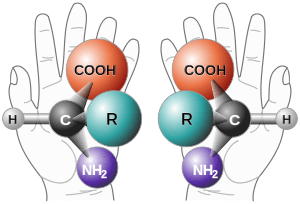
- Amino acids
Upon landing on the comet, Philae should have also tested some hypotheses as to why essential amino acids are almost all "left-handed", which refers to how the atoms arrange in orientation in relation to the carbon core of the molecule.[127] Most asymmetrical molecules are oriented in approximately equal numbers of left- and right-handed configurations (chirality), and the primarily left-handed structure of essential amino acids used by living organisms is unique. One hypothesis that will be tested was proposed in 1983 by William A. Bonner and Edward Rubenstein, Stanford University professors emeritus of chemistry and medicine respectively. They conjectured that when spiralling radiation is generated from a supernova, the circular polarisation of that radiation could then destroy one type of "handed" molecules. The supernova could wipe out one type of molecules while also flinging the other surviving molecules into space, where they could eventually end up on a planet.[128]
Preliminary results
The mission has yielded a significant science return, collecting a wealth of data from the nucleus and its environment at various levels of cometary activity.[129] The VIRTIS spectrometer on board the Rosetta spacecraft has provided evidence of nonvolatile organic macromolecular compounds everywhere on the surface of comet 67P with little to no water ice visible.[130] Preliminary analyses strongly suggest the carbon is present as polyaromatic organic solids mixed with sulfides and iron-nickel alloys.[131][132]
Solid organic compounds were also found in the dust particles emitted by the comet; the carbon in this organic material is bound in "very large macromolecular compounds", analogous to those found in carbonaceous chondrite meteorites.[133] However, no hydrated minerals were detected, suggesting no link with carbonaceous chondrites.[134]
In turn, the Philae lander's COSAC instrument detected organic molecules in the comet's atmosphere as it descended to its surface.[135][136] Measurements by the COSAC and Ptolemy instruments on the Philae's lander revealed sixteen organic compounds, four of which were seen for the first time on a comet, including acetamide, acetone, methyl isocyanate and propionaldehyde.[137][138][139] The only amino acid detected thus far on the comet is glycine,[140] along with the precursor molecules methylamine and ethylamine.[141]
One of the most outstanding discoveries of the mission was the detection of large amounts of free molecular oxygen (O
2) gas surrounding the comet.[142][143]
Timeline of major events and discoveries
- 2004
- 2 March – ESA's Rosetta mission was successfully launched at 07:17 UTC (04:17 local time) from Kourou, French Guiana.
- 2005
- 4 March – Rosetta executed its first planned close swing-by (gravity assist passage) of Earth. The Moon and the Earth's magnetic field were used to test and calibrate the instruments on board of the spacecraft. The minimum altitude above the Earth's surface was 1,954.7 km (1,214.6 mi).[64]
- 4 July – Imaging instruments on board observed the collision between the comet Tempel 1 and the impactor of the Deep Impact mission.[144]
- 2007
- 25 February – Mars flyby.[28][145]
- 8 November – Catalina Sky Survey briefly misidentified the Rosetta spacecraft, approaching for its second Earth flyby, as a newly discovered asteroid.
- 13 November – Second Earth swing-by at a minimum altitude of 5,295 km (3,290 mi), travelling at 45,000 km/h (28,000 mph).[146]
- 2008
- 5 September – Flyby of asteroid 2867 Šteins. The spacecraft passed the main-belt asteroid at a distance of 800 km (500 mi) and the relatively slow speed of 8.6 km/s (31,000 km/h; 19,000 mph).[147]
- 2009
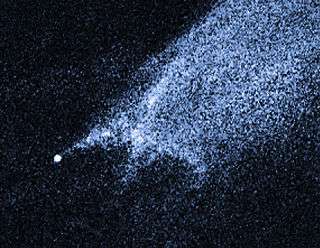
- 2010
- 16 March – Observation of the dust tail of asteroid P/2010 A2. Together with observations by Hubble Space Telescope it could be confirmed that P/2010 A2 is not a comet, but an asteroid, and that the tail most likely consists of particles from an impact by a smaller asteroid.[150]
- 10 July – Flew by and photographed the asteroid 21 Lutetia.[151]
- 2014
.jpg)
- May to July – Starting on 7 May, Rosetta began orbital correction manoeuvres to bring itself into orbit around 67P. At the time of the first deceleration burn Rosetta was approximately 2,000,000 km (1,200,000 mi) away from 67P and had a relative velocity of +775 m/s (2,540 ft/s); by the end of the last burn, which occurred on 23 July, the distance had been reduced to just over 4,000 km (2,500 mi) with a relative velocity of +7.9 m/s (18 mph).[18][152] In total eight burns were used to align the trajectories of Rosetta 67P with the majority of the deceleration occurring during three burns: Delta-v's of 291 m/s (650 mph) on 21 May, 271 m/s (610 mph) on 4 June, and 91 m/s (200 mph) on 18 June.[18]
- 14 July – The OSIRIS on-board imaging system returned images of comet 67P which confirmed the irregular shape of the comet.[153][154]
- 6 August – Rosetta arrives at 67P, approaching to 100 km (62 mi) and carrying out a thruster burn that reduces its relative velocity to 1 m/s (3.3 ft/s).[155][156][157] Commences comet mapping and characterisation to determine a stable orbit and viable landing location for Philae.[158]
- 4 September – The first science data from Rosetta's ALICE instrument was reported, showing that the comet is unusually dark in ultraviolet wavelengths, hydrogen and oxygen are present in the coma, and no significant areas of water-ice have been found on the comet's surface. Water-ice was expected to be found as the comet is too far from the Sun to turn water into vapour.[159]
- 10 September 2014 – Rosetta enters the Global Mapping Phase, orbiting 67P at an altitude of 29 km (18 mi).[5]
- 12 November 2014 – Philae lands on the surface of 67P.[13]
- 10 December 2014 – Data from the ROSINA mass spectrometers show that the ratio of heavy water to normal water on comet 67P is more than three times that on Earth. The ratio is regarded as a distinctive signature, and the discovery means that Earth's water is unlikely to have originated from comets like 67P.[96][97][98]
- 2015
- 14 April 2015 – Scientists report that the comet's nucleus has no magnetic field of its own.[94]
- 2 July 2015 – Scientists report that active pits, related to sinkhole collapses and possibly associated with outbursts, have been found on the comet.[160][161]
- 11 August 2015 – Scientists release images of a comet outburst that occurred on 29 July 2015.[162]
- 28 October 2015 – Scientists publish an article in Nature reporting high levels of molecular oxygen around 67P.[163][164]
- November 2014 to December 2015 – Rosetta escorted the comet around the Sun and performed riskier investigations.[103]
- 2016
- 27 July 2016 – ESA switched off the Electrical Support System Processor Unit (ESS) aboard Rosetta, disabling any possibility of further communications with the Philae lander.[15]
- 2 September 2016 - Rosetta photographs the Philae lander for the first time after its landing, finding it wedged against a large overhang.[165]
- 30 September 2016 - Mission ended in an attempt to slow land on the comet's surface near a 130 m (425 ft) wide pit called Deir el-Medina. The walls of the pit contain 0.91 m (3 ft) wide so-called "goose bumps", believed to represent the building blocks of the comet.[16][17][166] Although Philae sent back some data during its descent, Rosetta has more powerful and more varied sensors and instruments, offering the opportunity to get some very close-in science to complement the more distant remote sensing it has been doing. The orbiter descended more slowly than Philae did.[167][168]
Media coverage
The entire mission was featured heavily in social media, with a Facebook account for the mission and both the satellite and the lander having an official Twitter account portraying a personification of both spacecraft. The hashtag "#CometLanding" gained widespread traction. A Livestream of the control centres was set up, as were multiple official and unofficial events around the world to follow Philae's landing on 67P.[169][170] On 23 September 2016, Vangelis released the studio album Rosetta in honour of the mission,[171][172] which was used on 30 September in the "Rosetta's final hour" streaming video of the ESA Livestream event "Rosetta Grand Finale".[173]
- Video reports by the German Aerospace Center
-
About Rosetta's mission
(9 min., 1080p HD, English) -
About Philae's landing
(10 min., 1080p HD, English)
See also
- Deep Impact (spacecraft)
- Giotto (spacecraft)
- Halley Armada
- Hayabusa — successful sample-return mission to an asteroid
- List of missions to Mars
- Stardust (spacecraft)
- Timeline of Solar System exploration
References
- ↑ "Rosetta at a glance — technical data and timeline". German Aerospace Center. Archived from the original on 8 January 2014. Retrieved 8 January 2014.
- 1 2 "No. 1 - Rosetta in Good Health". Status Reports. European Space Agency. 4 March 2004. Retrieved 7 October 2016.
- ↑ Baldwin, Emily (3 October 2016). "Rosetta impact site named Sais". European Space Agency. Retrieved 7 October 2016.
- ↑ "Rosetta timeline: countdown to comet arrival". European Space Agency. 5 August 2014. Retrieved 6 August 2014.
- 1 2 Scuka, Daniel (10 September 2014). "Down, down we go to 29 km – or lower?". European Space Agency. Retrieved 13 September 2014.
- ↑ "No. 2 — Activating Rosetta". European Space Agency. 8 March 2004. Retrieved 8 January 2014.
- ↑ "We are working on flight control and science operations for Rosetta, now orbiting comet 67P, and Philae, which landed on the comet surface last week. Ask us Anything! AMA!". Reddit. 20 November 2014. Retrieved 21 November 2014.
- ↑ Agle, D. C.; Brown, Dwayne; Bauer, Markus (30 June 2014). "Rosetta's Comet Target 'Releases' Plentiful Water". NASA. Retrieved 30 June 2014.
- ↑ Chang, Kenneth (5 August 2014). "Rosetta Spacecraft Set for Unprecedented Close Study of a Comet". The New York Times. Retrieved 5 August 2014.
- 1 2 Bibring, Jean-Pierre; Schwehm, Gerhard (25 February 2007). "Stunning view of Rosetta skimming past Mars". European Space Agency. Retrieved 21 January 2014.
- ↑ Auster, H. U.; Richter, I.; Glassmeier, K. H.; Berghofer, G.; Carr, C. M.; Motschmann, U. (July 2010). "Magnetic field investigations during Rosetta's 2867 Šteins flyby". Planetary and Space Science. 58 (9): 1124–1128. Bibcode:2010P&SS...58.1124A. doi:10.1016/j.pss.2010.01.006.
- 1 2 Pätzold, M.; Andert, T. P.; Asmar, S. W.; Anderson, J. D.; Barriot, J.-P.; et al. (October 2011). "Asteroid 21 Lutetia: Low Mass, High Density". Science. 334 (6055): 491–492. Bibcode:2011Sci...334..491P. doi:10.1126/science.1209389.
- 1 2 3 Beatty, Kelly (12 November 2014). "Philae Lands on Its Comet – Three Times!". Sky & Telescope. Retrieved 26 November 2014.
- 1 2 Beatty, Kelly (15 November 2014). "Philae Wins Race to Return Comet Findings". Sky & Telescope. Retrieved 2 November 2015.
- 1 2 Mignone, Claudia (26 July 2016). "Farewell, silent Philae". European Space Agency. Retrieved 29 July 2016.
- 1 2 Aron, Jacob (30 September 2016). "Rosetta lands on 67P in grand finale to two year comet mission". New Scientist. Retrieved 1 October 2016.
- 1 2 3 Gannon, Megan (30 September 2016). "Goodbye, Rosetta! Spacecraft Crash-Lands on Comet in Epic Mission Finale". Space.com. Retrieved 1 October 2016.
- 1 2 3 4 5 Scuka, Daniel (7 May 2014). "Thruster burn kicks off crucial series of manoeuvres". European Space Agency. Retrieved 21 May 2014.
- 1 2 3 Fischer, D. (6 August 2014). "Rendezvous with a crazy world". The Planetary Society. Archived from the original on 6 August 2014. Retrieved 6 August 2014.
- 1 2 3 Bauer, M. (6 August 2014). "Rosetta Arrives at Comet Destination". European Space Agency. Archived from the original on 6 August 2014. Retrieved 6 August 2014.
- 1 2 Lakdawalla, Emily (15 August 2014). "Finding my way around comet Churyumov-Gerasimenko". The Planetary Society. Archived from the original on 15 August 2014. Retrieved 15 August 2014.
- ↑ Algar, Jim (14 October 2014). "Rosetta's lander Philae snaps selfie with comet". Tech Times. Retrieved 19 October 2014.
- ↑ Agle, D. C.; Cook, Jia-Rui; Brown, Dwayne; Bauer, Markus (17 January 2014). "Rosetta: To Chase a Comet". NASA. Retrieved 18 January 2014.
- ↑ "Rosetta at a glance". European Space Agency. Archived from the original on 14 May 2011. Retrieved 4 October 2010.
- ↑ Pearson, Michael; Smith, Matt (21 January 2014). "Comet-chasing probe wakes up, calls home". CNN. Retrieved 21 January 2014.
- ↑ Bauer, Markus (3 September 2014). "RSGS: The Rosetta Science Ground Segment". European Space Agency. Retrieved 20 November 2014.
- 1 2 Gilpin, Lyndsey (14 August 2014). "The tech behind the Rosetta comet chaser: From 3D printing to solar power to complex mapping". TechRepublic.
- 1 2 3 Keller, Uwe; Schwehm, Gerhard (25 February 2007). "Beautiful new images from Rosetta's approach to Mars: OSIRIS Update". European Space Agency.
- ↑ Glassmeier, Karl-Heinz; Boehnhardt, Hermann; Koschny, Detlef; Kührt, Ekkehard; Richter, Ingo (February 2007). "The Rosetta Mission: Flying Towards the Origin of the Solar System". Space Science Reviews. 128 (1–4): 1–21. Bibcode:2007SSRv..128....1G. doi:10.1007/s11214-006-9140-8.
- 1 2 3 4 Amos, Jonathan (4 October 2010). "Asteroid Lutetia has thick blanket of debris". BBC News. Retrieved 21 January 2014.
- ↑ Jordans, Frank (20 January 2014). "Comet-chasing probe sends signal to Earth". Excite News. Associated Press. Archived from the original on 2 February 2014. Retrieved 20 January 2014.
- ↑ Morin, Monte (20 January 2014). "Rise and shine Rosetta! Comet-hunting spacecraft gets wake-up call". Los Angeles Times. Science Now. Retrieved 21 January 2014.
- ↑ Agle, D. C.; Webster, Guy; Brown, Dwayne; Bauer, Markus (12 November 2014). "Rosetta's 'Philae' Makes Historic First Landing on a Comet". NASA. Retrieved 13 November 2014.
- ↑ Chang, Kenneth (12 November 2014). "European Space Agency's Spacecraft Lands on Comet's Surface". The New York Times. Retrieved 12 November 2014.
- ↑ "Rosetta: Comet Probe Beams Back Pictures". Sky News. 12 November 2014. Retrieved 12 November 2014.
- ↑ Bauer, Markus (5 September 2016). "Philae found!". European Space Agency. Retrieved 5 September 2016.
- ↑ Turk, Victoria (14 March 2016). "Happy Anniversary Giotto, the Probe That Flew By Halley's Comet 30 Years Ago". Vice. Motherboard. Retrieved 1 October 2016.
- 1 2 Altwegg, Kathrin; Huntress, Jr, Wesley T. (2001). "The constituents of cometary nuclei". In Bleeker, Johan A. M.; Geiss, Johannes; Huber, Martin C. E. The Century of Space Science. Kluwer Academic. p. 1280. ISBN 0-7923-7196-8.
- ↑ Neugebauer, M.; Draper, R. F. (1987). "The Comet Rendezvous Asteroid Flyby Mission". Advances in Space Research. 7 (12): 201-204. Bibcode:1987AdSpR...7..201N. doi:10.1016/0273-1177(87)90218-3.
- ↑ Schwehm, G. H. (1989). "Rosetta - Comet Nucleus Sample Return". Advances in Space Research. 9 (6): 185-190. Bibcode:1989AdSpR...9..185S. doi:10.1016/0273-1177(89)90228-7.
- 1 2 Moltenbrey, Michael (2016). "Exploration of Small Solar System Bodies". Dawn of Small Worlds: Dwarf Planets, Asteroids, Comets. Astronomer's Universe. Springer. pp. 223–224. doi:10.1007/978-3-319-23003-0. ISBN 978-3-319-23002-3.
- ↑ Sharp, Tim (15 January 2014). "Rosetta Spacecraft: To Catch a Comet". Space.com. Retrieved 25 January 2014.
- ↑ "Unlocking the secrets of the universe: Rosetta lander named Philae". European Space Agency. 5 February 2004. Retrieved 25 January 2014.
- ↑ "ESA's Rosetta Probe begins approach of comet 67P". Long Now. 6 June 2014. Retrieved 6 August 2014.
- ↑ "Europe's Comet Chaser-historic mission". European Space Agency. 16 January 2014. Retrieved 5 August 2014.
- ↑ "Rosetta Factsheet". European Space Agency. 9 September 2016. Retrieved 1 October 2016.
- ↑ "Europe's Rosetta probe goes into orbit around comet 67P". BBC News. 6 August 2014. Retrieved 6 August 2014.
- ↑ "Rosetta: Fact Sheet". European Space Agency. Retrieved 19 July 2016.
- 1 2 3 "Rosetta". National Space Science Data Center. NASA. Retrieved 3 November 2014.
- 1 2 "The Rosetta orbiter". European Space Agency. 16 January 2014. Retrieved 13 August 2014.
- 1 2 D'Accolti, G.; Beltrame, G.; Ferrando, E.; Brambilla, L.; Contini, R.; et al. (2002). The Solar Array Photovoltaic Assembly for the ROSETTA Orbiter and Lander Spacecraft's. 6th European Space Power Conference. 6–10 May 2002. Porto, Portugal. Bibcode:2002ESASP.502..445D.
- ↑ Stage, Mie (19 January 2014). "Terma-elektronik vækker rumsonde fra årelang dvale". Ingeniøren. Retrieved 2 December 2014.
- ↑ Jensen, Hans; Laursen, Johnny (2002). Power Conditioning Unit for Rosetta/Mars Express. 6th European Space Power Conference. 6–10 May 2002. Porto, Portugal. Bibcode:2002ESASP.502..249J.
- ↑ Stramaccioni, D. (2004). The Rosetta Propulsion System. 4th International Spacecraft Propulsion Conference. 2–9 June 2004. Sardinia, Italy. Bibcode:2004ESASP.555E...3S.
- ↑ "No bugs please, this is a clean planet!". European Space Agency. 30 July 2002. Retrieved 7 March 2007.
- ↑ Gibney, Elizabeth (17 July 2014). "Duck-shaped comet could make Rosetta landing more difficult". Nature. doi:10.1038/nature.2014.15579. Retrieved 15 November 2014.
- ↑ Harland, David M.; Lorenz, Ralph D. (2006). "The Current Crop". Space Systems Failures. Springer-Praxis. pp. 149–150. ISBN 0-387-21519-0.
- ↑ "New destination for Rosetta, Europe's comet chaser". European Space Agency. 29 May 2003. Retrieved 7 October 2016.
- ↑ Butler, Declan (22 May 2003). "Spiralling costs dog comet mission". Nature. 423 (6938): 372. doi:10.1038/423372b.
- ↑ Ulamec, S.; Espinasse, S.; Feuerbacher, B.; Hilchenbach, M.; Moura, D.; et al. (April 2006). "Rosetta Lander—Philae: Implications of an alternative mission". Acta Astronautica. 58 (8): 435–441. Bibcode:2006AcAau..58..435U. doi:10.1016/j.actaastro.2005.12.009.
- ↑ "Svetlana Gerasimenko and Klim Churyumov in Kourou". Rosetta. European Space Agency. 20 October 2014. Retrieved 15 October 2016.
- ↑ "Klim Churyumov - co-discoverer of comet 67P". Rosetta. European Space Agency. 20 October 2014. Retrieved 15 October 2016.
- 1 2 3 4 5 "Rosetta's Frequently Asked Questions". European Space Agency. Retrieved 24 May 2014.
- 1 2 Montagnon, Elsa; Ferri, Paolo (July 2006). "Rosetta on its way to the outer Solar System". Acta Astronautica. 59 (1–5): 301–309. Bibcode:2006AcAau..59..301M. doi:10.1016/j.actaastro.2006.02.024.
- ↑ "Rosetta Rendezvous Mission with Comet 67P/Churyumov-Gerasimenko". eoPortal. European Space Agency. Retrieved 1 October 2016.
- ↑ "Rosetta correctly lined up for critical Mars swingby". European Space Agency. 15 February 2007. Retrieved 21 January 2014.
- ↑ "Europe set for billion-euro gamble with comet-chasing probe". Phys.org. 23 February 2007. Archived from the original on 25 February 2007.
- ↑ Keller, Horst Uwe; Sierks, Holger (15 November 2007). "First OSIRIS images from Rosetta Earth swing-by". Max Planck Institute for Solar System Research. Archived from the original on 7 March 2008.
- ↑ Lakdawalla, Emily (2 November 2007). "Science plans for Rosetta's Earth flyby". The Planetary Society. Retrieved 21 January 2014.
- ↑ "M.P.E.C. 2007-V69". Minor Planet Center. Retrieved 6 October 2015.
- ↑ Sutherland, Paul (10 November 2007). "'Deadly asteroid' is a spaceprobe". Skymania. Retrieved 21 January 2014.
- ↑ Lakdawalla, Emily (9 November 2007). "That's no near-Earth object, it's a spaceship!". The Planetary Society. Retrieved 21 January 2014.
- ↑ Tomatic, A. U. (9 November 2007). "MPEC 2007-V70: Editorial Notice". Minor Planet Electronic Circular. Minor Planet Center. Retrieved 21 January 2014.
- ↑ "First Asteroid". Aviation Week & Space Technology. 169 (10): 18. 15 September 2008.
- ↑ "Rosetta makes final home call". BBC News. 12 November 2009. Retrieved 22 May 2010.
- 1 2 Sierks, H.; Lamy, P.; Barbieri, C.; Koschny, D.; Rickman, H.; et al. (October 2011). "Images of Asteroid 21 Lutetia: A Remnant Planetesimal from the Early Solar System". Science. 334 (6055): 487–90. Bibcode:2011Sci...334..487S. doi:10.1126/science.1207325. PMID 22034428.
- ↑ Amos, Jonathan (21 May 2014). "Rosetta comet-chaser initiates 'big burn'". BBC News. Retrieved 24 May 2014.
- ↑ Clark, Stephen (29 January 2014). "ESA says Rosetta in good shape after 31-month snooze". Spaceflight Now. Retrieved 29 July 2014.
- ↑ Scuka, Daniel (23 July 2014). "Last of the FATties". European Space Agency. Retrieved 31 July 2014.
- ↑ Agle, D. C.; Brown, Dwayne; Bauer, Markus (25 August 2014). "Rosetta: Landing site search narrows". NASA. Retrieved 26 August 2014.
- ↑ Amos, Jonathan (4 November 2014). "Rosetta comet mission: Landing site named 'Agilkia'". BBC News. Retrieved 5 November 2014.
- ↑ Bauer, Markus (15 September 2014). "'J' Marks the Spot for Rosetta's Lander". European Space Agency. Retrieved 20 September 2014.
- ↑ Knapton, Sarah (12 November 2014). "Rosetta mission: broken thrusters mean probe could bounce off comet into space". The Daily Telegraph. Retrieved 12 November 2014.
- ↑ Withnall, Adam; Vincent, James (13 November 2014). "Philae lander 'bounced twice' on comet but is now stable, Rosetta mission scientists confirm". The Independent. Retrieved 26 November 2014.
- ↑ "Rosetta camera captures Philae's descent to the comet". Spaceflight Now. 13 November 2014. Retrieved 26 November 2014.
- ↑ Dambeck, Thorsten (21 January 2014). "Expedition to primeval matter". Max-Planck-Gesellschaft. Retrieved 19 September 2014.
- ↑ Wall, Mike (30 July 2015). "Surprising Comet Discoveries by Rosetta's Philae Lander Unveiled". Space.com. Retrieved 31 July 2015.
- ↑ Meierhenrich, Uwe (2008). Amino Acids and the Asymmetry of Life. Springer-Verlag. doi:10.1007/978-3-540-76886-9. ISBN 978-3-540-76885-2.
- 1 2 3 "Philae found!". European Space Agency. 5 September 2016. Retrieved 5 September 2016.
- ↑ Bauer, Markus (12 February 2016). "Rosetta's Lander Faces Eternal Hibernation". European Space Agency. Retrieved 14 February 2016.
- ↑ Mignone, Claudia (26 July 2016). "Farewell, silent Philae". European Space Agency. Retrieved 5 September 2016.
- ↑ Fessenden, Marissa (12 November 2014). "Comet 67P Has a Welcome Song for Rosetta And Philae". Smart News. Smithsonian.com. Retrieved 26 December 2014.
- ↑ Edwards, Tim (14 November 2014). "Music emitted from Comet 67P sounds an awful lot like 20th-century harpsichord masterpiece". Classic FM. Retrieved 26 December 2014.
- 1 2 Bauer, Markus (14 April 2015). "Rosetta and Philae Find Comet Not Magnetised". European Space Agency. Retrieved 14 April 2015.
- ↑ Schiermeier, Quirin (14 April 2015). "Rosetta's comet has no magnetic field". Nature. doi:10.1038/nature.2015.17327.
- 1 2 Agle, D.C.; Bauer, Markus (10 December 2014). "Rosetta Instrument Reignites Debate on Earth's Oceans". NASA. Retrieved 10 December 2014.
- 1 2 Chang, Kenneth (10 December 2014). "Comet Data Clears Up Debate on Earth's Water". The New York Times. Retrieved 10 December 2014.
- 1 2 Morelle, Rebecca (10 December 2014). "Rosetta results: Comets 'did not bring water to Earth'". BBC News. Retrieved 11 December 2014.
- ↑ Agle, D. C.; Brown, Dwayne; Bauer, Markus (22 January 2015). "Rosetta Comet 'Pouring' More Water Into Space". NASA. Retrieved 22 January 2015.
- ↑ Agle, D. C.; Brown, Dwayne; Fohn, Joe; Bauer, Markus (2 June 2015). "NASA Instrument on Rosetta Makes Comet Atmosphere Discovery". NASA. Retrieved 2 June 2015.
- ↑ Feldman, Paul D.; A'Hearn, Michael F.; Bertaux, Jean-Loup; Feaga, Lori M.; Parker, Joel Wm.; et al. (2 June 2015). "Measurements of the near-nucleus coma of comet 67P/Churyumov-Gerasimenko with the Alice far-ultraviolet spectrograph on Rosetta". Astronomy and Astrophysics. 583. A8. Bibcode:2015A&A...583A...8F. doi:10.1051/0004-6361/201525925.
- ↑ Bauer, Markus (30 June 2016). "Rosetta finale set for 30 September". European Space Agency. Retrieved 7 October 2016.
- 1 2 Bauer, Markus (23 June 2015). "Rosetta mission extended". European Space Agency. Retrieved 11 July 2015.
- 1 2 "Mission complete: Rosetta's journey ends in daring descent to comet". European Space Agency. 30 September 2016. Retrieved 7 October 2016.
- 1 2 Cowen, Ron (30 September 2016). "Rosetta Spacecraft Death-Dives into Comet Companion—On Purpose". Eos. 97. doi:10.1029/2016EO060243. Retrieved 7 October 2016.
- 1 2 Clark, Stephen (30 September 2016). "Rosetta mission ends with comet touchdown". Spaceflight Now. Retrieved 7 October 2016.
- 1 2 3 Gibney, Elizabeth (30 September 2016). "Mission accomplished: Rosetta crashes into comet". Nature. 538 (7623). doi:10.1038/nature.2016.20705. Retrieved 7 October 2016.
- ↑ "Screenshot of the last packet...". Twitter.com. ESA Operations. 30 September 2016. Retrieved 7 October 2016. Note: Times in the left column are Spacecraft Event Time, while the right column is Earth Received Time. All times are in UTC.
- ↑ Stern, S. A.; Slater, D. C.; Scherrer, J.; Stone, J.; Versteeg, M.; et al. (February 2007). "Alice: The Rosetta Ultraviolet Imaging Spectrograph". Space Science Reviews. 128 (1–4): 507–527. arXiv:astro-ph/0603585
 . Bibcode:2007SSRv..128..507S. doi:10.1007/s11214-006-9035-8.
. Bibcode:2007SSRv..128..507S. doi:10.1007/s11214-006-9035-8. - ↑ Stern, S. A.; Slater, D. C.; Gibson, W.; Scherrer, J.; A'Hearn, M.; et al. (1998). "Alice—An Ultraviolet Imaging Spectrometer for the Rosetta Orbiter". Advances in Space Research. 21 (11): 1517–1525. Bibcode:1998AdSpR..21.1517S. doi:10.1016/S0273-1177(97)00944-7.
- ↑ Thomas, N.; Keller, H. U.; Arijs, E.; Barbieri, C.; Grande, M.; et al. (1998). "Osiris—The optical, spectroscopic and infrared remote imaging system for the Rosetta Orbiter". Advances in Space Research. 21 (11): 1505–1515. Bibcode:1998AdSpR..21.1505T. doi:10.1016/S0273-1177(97)00943-5.
- ↑ Coradini, A.; Capaccioni, F.; Capria, M. T.; Cerroni, P.; de Sanctis, M. C.; et al. (March 1996). "VIRTIS Visible Infrared Thermal Imaging Spectrometer for Rosetta Mission". Lunar and Planetary Science. 27: 253. Bibcode:1996LPI....27..253C. doi:10.1109/igarss.1995.521822. ISBN 0-7803-2567-2.
- ↑ Kofman, W.; Herique, A.; Goutail, J.-P.; Hagfors, T.; Williams, I. P.; et al. (February 2007). "The Comet Nucleus Sounding Experiment by Radiowave Transmission (CONSERT): A Short Description of the Instrument and of the Commissioning Stages". Space Science Reviews. 128 (1–4): 414–432. Bibcode:2007SSRv..128..413K. doi:10.1007/s11214-006-9034-9.
- ↑ "RSI: Radio Science Investigation". European Space Agency. Retrieved 26 November 2014.
- ↑ Balsiger, H.; Altwegg, K.; Arijs, E.; Bertaux, J.-L.; Berthelier, J.-J.; et al. (1998). "Rosetta Orbiter Spectrometer for Ion and Neutral Analysis—ROSINA". Advances in Space Research. 21 (11): 1527–1535. Bibcode:1998AdSpR..21.1527B. doi:10.1016/S0273-1177(97)00945-9.
- ↑ Riedler, W.; Torkar, K.; Rüdenauer, F.; Fehringer, M.; Schmidt, R.; et al. (1998). "The MIDAS experiment for the Rosetta mission". Advances in Space Research. 21 (11): 1547–1556. Bibcode:1998AdSpR..21.1547R. doi:10.1016/S0273-1177(97)00947-2.
- ↑ Engrand, Cecile; Kissel, Jochen; Krueger, Franz R.; Martin, Philippe; Silén, Johan; et al. (April 2006). "Chemometric evaluation of time-of-flight secondary ion mass spectrometry data of minerals in the frame of future in situ analyses of cometary material by COSIMA onboard ROSETTA". Rapid Communications in Mass Spectrometry. 20 (8): 1361–1368. doi:10.1002/rcm.2448. PMID 16555371.
- ↑ Colangeli, L.; Lopez-Moreno, J. J.; Palumbo, P.; Rodriguez, J.; Cosi, M.; et al. (February 2007). "The Grain Impact Analyser and Dust Accumulator (GIADA) experiment for the Rosetta mission: design, performances and first results". Space Science Reviews. 128 (1–4): 803–821. Bibcode:2007SSRv..128..803C. doi:10.1007/s11214-006-9038-5.
- ↑ Della Corte, V.; Rotundi, A.; Accolla, M.; Sordini, R.; Palumbo, P.; et al. (March 2014). "GIADA: its status after the Rosetta cruise phase and on-ground activity in support of the encounter with comet 67P/Churyumov-Gerasimenko". Journal of Astronomical Instrumentation. 3 (1): 1–11. Bibcode:2014JAI.....350011D. doi:10.1142/S2251171713500116.
- ↑ Trotignon, J. G.; Boström, R.; Burch, J. L.; Glassmeier, K.-H.; Lundin, R.; et al. (January 1999). "The Rosetta plasma consortium: Technical realization and scientific aims". Advances in Space Research. 24 (9): 1149–1158. Bibcode:1999AdSpR..24.1149T. doi:10.1016/S0273-1177(99)80208-7.
- ↑ Glassmeier, Karl-Heinz; Richter, Ingo; Diedrich, Andrea; Musmann, Günter; Auster, Uli; et al. (February 2007). "RPC-MAG The Fluxgate Magnetometer in the ROSETTA Plasma Consortium". Space Science Reviews. 128 (1–4): 649–670. Bibcode:2007SSRv..128..649G. doi:10.1007/s11214-006-9114-x.
- ↑ Hoover, Rachel (21 February 2014). "Need to Track Organic Nano-Particles Across the Universe? NASA's Got an App for That". NASA.
- ↑ Chang, Kenneth (18 August 2009). "From a Distant Comet, a Clue to Life". The New York Times. Space & Cosmos. p. A18.
- ↑ Tate, Karl (17 January 2014). "How the Rosetta Spacecraft Will Land on a Comet". Space.com. Retrieved 9 August 2014.
A previous sample-return mission to a different comet found particles of organic matter that are the building blocks of life.
- 1 2 Kremer, Ken (6 August 2014). "Rosetta Arrives at 'Scientific Disneyland' for Ambitious Study of Comet 67P/Churyumov-Gerasimenko after 10 Year Voyage". Universe Today. Retrieved 9 August 2014.
- ↑ Baldwin, Emily (26 June 2015). "Rosetta and Philae: Searching for a good signal". European Space Agency. Retrieved 26 June 2015.
- ↑ Thiemann, Wolfram H.-P.; Meierhenrich, Uwe (February 2001). "ESA Mission ROSETTA Will Probe for Chirality of Cometary Amino Acids". Origins of Life and Evolution of the Biosphere. 21 (1–2): 199–210. doi:10.1023/A:1006718920805.
- ↑ Bergeron, Louis (17 October 2007). "William Bonner, professor emeritus of chemistry, dead at 87". Stanford Report. Retrieved 8 August 2014.
- ↑ Martin, Patrick (April 2016). Rosetta Mission Status: Toward the End of Comet Phase Operations (PDF). EGU General Assembly 2016. 17-22 April 2016. Vienna Austria. Bibcode:2016EGUGA..1817068M. EGU2016-17068.
- ↑ Capaccioni, F.; Coradini, A.; Filacchione, G.; Erard, S.; Arnold, G.; et al. (23 January 2015). "The organic-rich surface of comet 67P/Churyumov-Gerasimenko as seen by VIRTIS/Rosetta". Science. 347 (6220): aaa0628. Bibcode:2015Sci...347a0628C. doi:10.1126/science.aaa0628.
- ↑ Quirico, E.; Moroz, L. V.; Beck, P.; Schmitt, B.; Arnold, G.; et al. (March 2015). Composition of Comet 67P/Churymov-Gerasimenko Refractory Crust as Inferred from VIRTIS-M/Rosetta Spectro-Imager (PDF). 46th Lunar and Planetary Science Conference. 16–20 March 2015. The Woodlands, Texas. Bibcode:2015LPI....46.2092Q. LPI Contribution No. 1832, p. 2092.
- ↑ Quirico, E.; Moroz, L. V.; Schmitt, B.; Arnold, G.; Faure, M.; et al. (July 2016). "Refractory and semi-volatile organics at the surface of comet 67P/Churyumov-Gerasimenko: Insights from the VIRTIS/Rosetta imaging spectrometer". Icarus. 272: 32–47. Bibcode:2016Icar..272...32Q. doi:10.1016/j.icarus.2016.02.028.
- ↑ Fray, Nicolas; Bardyn, Anaïs; Cottin, Hervé; et al. (6 October 2016). "High-molecular-weight organic matter in the particles of comet 67P/Churyumov–Gerasimenko". Nature. 538: 72–74. doi:10.1038/nature19320.
- ↑ Quirico, E.; Moroz, L. V.; Schmitt, B.; et al. (1 July 2016). "Refractory and semi-volatile organics at the surface of comet 67P/Churyumov-Gerasimenko: Insights from the VIRTIS/Rosetta imaging spectrometer". Icarus. 272: 32–47. Bibcode:2016Icar..272...32Q. doi:10.1016/j.icarus.2016.02.028.
- ↑ Rincon, Paul (18 November 2014). "Comet landing: Organic molecules detected by Philae". BBC News. Retrieved 6 April 2015.
- ↑ Grey, Richard (19 November 2014). "Rosetta mission lander detects organic molecules on surface of comet". The Guardian. Retrieved 6 April 2015.
- ↑ Jordans, Frank (30 July 2015). "Philae probe gets a 'sniff' of acetone, indicating comets can concoct complex compounds". U.S. News & World Report. Associated Press. Retrieved 5 October 2016.
- ↑ "Science on the Surface of a Comet". European Space Agency. 30 July 2015. Retrieved 30 July 2015.
- ↑ Bibring, J.-P.; Taylor, M.G.G.T.; Alexander, C.; Auster, U.; Biele, J.; Finzi, A. Ercoli; Goesmann, F.; Klingehoefer, G.; Kofman, W.; Mottola, S.; Seidenstiker, K.J.; Spohn, T.; Wright, I. (31 July 2015). "Philae's First Days on the Comet - Introduction to Special Issue". Science. 349 (6247): 493. Bibcode:2015Sci...349..493B. doi:10.1126/science.aac5116. Retrieved 30 July 2015.
- ↑ Altwegg, Kathrin; Balsiger, Hans; Bar-Nun, Akiva; Berthelier, Jean-Jacques; Bieler, Andre; et al. (27 May 2016). "Prebiotic chemicals—amino acid and phosphorus—in the coma of comet 67P/Churyumov-Gerasimenko". Science Advances. 2 (5): e1600285. Bibcode:2016SciA....2E0285A. doi:10.1126/sciadv.1600285. PMC 4928965
 . PMID 27386550.
. PMID 27386550. - ↑ Altwegg, Kathrin; Balsiger, Hans; et al. (27 May 2016). "Prebiotic chemicals—amino acid and phosphorus—in the coma of comet 67P/Churyumov-Gerasimenko". Science Advances. 2 (5): e1600285. Bibcode:2016SciA....2E0285A. doi:10.1126/sciadv.1600285. PMID 27386550. Retrieved 2 October 2016.
- ↑ Bieler, A.; et al. (29 October 2015). "Abundant molecular oxygen in the coma of comet 67P/Churyumov–Gerasimenko". Nature. 526 (7575): 678–681. Bibcode:2015Natur.526..678B. doi:10.1038/nature15707. PMID 26511578.
- ↑ Howell, Elizabeth (28 October 2015). "Modern Mystery: Ancient Comet Is Spewing Oxygen". Space.com. Retrieved 6 November 2015.
- ↑ Schwehm, Gerhard (4 July 2005). "Rosetta camera view of Tempel 1 brightness". European Space Agency. Retrieved 21 January 2014.
- ↑ Schwehm, Gerhard (25 February 2007). "Rosetta successfully swings-by Mars – next target: Earth". European Space Agency. Retrieved 21 January 2014.
- ↑ Schwehm, Gerhard; Accomazzo, Andrea; Schulz, Rita (13 November 2007). "Rosetta swing-by a success". European Space Agency. Retrieved 7 August 2014.
- ↑ "Encounter of a different kind: Rosetta observes asteroid at close quarters". European Space Agency. 6 September 2008. Retrieved 29 May 2009.
- ↑ "Last visit home for ESA's comet chaser". European Space Agency. 20 October 2009. Retrieved 8 November 2009.
- ↑ "Rosetta bound for outer Solar System after final Earth swingby". European Space Agency. 13 November 2009. Retrieved 7 August 2014.
- ↑ Snodgrass, Colin; Tubiana, Cecilia; Vincent, Jean-Baptiste; Sierks, Holger; Hviid, Stubbe; et al. (October 2010). "A collision in 2009 as the origin of the debris trail of asteroid P/2010 A2". Nature. 467 (7317): 814–816. arXiv:1010.2883
 . Bibcode:2010Natur.467..814S. doi:10.1038/nature09453. PMID 20944742.
. Bibcode:2010Natur.467..814S. doi:10.1038/nature09453. PMID 20944742. - ↑ Chow, Denise (10 July 2010). "Mysterious Asteroid Unmasked By Space Probe Flyby". Space.com. Retrieved 10 July 2010.
- ↑ Scuka, Daniel (20 May 2014). "The Big Burns – Part 1". European Space Agency. Retrieved 21 May 2014.
- ↑ "The twofold comet: Comet 67P/Churyumov-Gerasimenko". Astronomy.com. 17 July 2014. Retrieved 18 July 2014.
- ↑ Temming, Maria (17 July 2014). "Rosetta's Comet has a Split Personality". Sky & Telescope. Retrieved 18 July 2014.
- ↑ ESA Operations (6 August 2014). "Thruster burn complete". Twitter.com. Retrieved 6 August 2014.
- ↑ Scuka, Daniel (3 June 2014). "The Big Burns – Part 2". European Space Agency. Retrieved 9 June 2014.
- ↑ Rkaina, Sam (6 August 2014). "Rosetta probe: Recap updates after spacecraft successfully reached deep space comet orbit". Daily Mirror. Retrieved 6 August 2014.
- ↑ Amos, Jonathan (14 August 2014). "Rosetta: Comet probe gets down to work". BBC News. Retrieved 15 August 2014.
- ↑ Brown, Dwayne; Agle, A. G.; Martinez, Maria; Bauer, Markus (4 September 2014). "NASA Instrument aboard European Spacecraft Returns First Science Results". NASA. Release 14-238. Retrieved 5 September 2014.
- ↑ Vincent, Jean-Baptiste; et al. (2 July 2015). "Large heterogeneities in comet 67P as revealed by active pits from sinkhole collapse". Nature. 523 (7558): 63–66. Bibcode:2015Natur.523...63V. doi:10.1038/nature14564.
- ↑ Ritter, Malcolm (1 July 2015). "It's the pits: Comet appears to have sinkholes, study says". Associated Press. Retrieved 2 July 2015.
- ↑ "PIA19867: Rosetta Comet In Action (Animation)". NASA. 11 August 2015. Retrieved 11 August 2015.
- ↑ Bieler, A.; Altwegg, K.; Balsiger, H.; Bar-Nun, A.; Berthelier, J.-J.; et al. (29 October 2015). "Abundant molecular oxygen in the coma of comet 67P/Churyumov–Gerasimenko". Nature. 526 (7575): 678–681. Bibcode:2015Natur.526..678B. doi:10.1038/nature15707.
- ↑ "Comet gives clues to Earth's beginning". Radio New Zealand. 28 October 2015. Retrieved 29 October 2015.
- ↑ Amos, Jonathan (5 September 2016). "Philae: Lost comet lander is found". BBC News. Retrieved 5 September 2016.
- ↑ Chang, Kenneth (26 September 2016). "For Rosetta, a Landing and an Ending on a Comet". The New York Times. Retrieved 26 September 2016.
- ↑ Gibney, Elizabeth (4 November 2015). "Historic Rosetta mission to end with crash into comet". Nature. 527. pp. 16–17. doi:10.1038/527016a. Retrieved 5 November 2015.
- ↑ Amos, Jonathan (30 June 2016). "Rosetta comet probe given termination date". BBC News. Retrieved 2 July 2016.
- ↑ "Live updates: Rosetta mission comet landing". 12 November 2014.
- ↑ "Call for Media Opportunities to Follow Rosetta Mission's Historic Comet Landing". European Space Agency. 16 October 2014.
- ↑ Welsh, April Clare (29 July 2016). "Vangelis to release Rosetta album inspired by comet landing mission". Fact. Retrieved 18 August 2016.
- ↑ Sheahan, Maria; Bryan, Victoria (22 September 2016). "Europe's Rosetta spacecraft to end epic trek with comet crash landing". Reuters. Retrieved 6 November 2016.
- ↑ Rosetta Grand Finale. Livestream. 30 September 2016. Event occurs at 01:02:19-01:13:35. Retrieved 6 November 2016.
External links
| Wikimedia Commons has media related to Rosetta (spacecraft). |
| Wikinews has news related to: |
- Rosetta website at ESA.int
- Rosetta news site at ESA.int
- Rosetta operations site at ESA.int
- Rosetta website at NASA.gov
- Rosetta mission profile at NASA.gov
- Media
- Rosetta outreach image gallery at ESA.int
- Rosetta raw image gallery at ESA.int
- Rosetta image gallery at Flickr.com
- Rosetta's journey through the solar system and orbit around comet 67P at YouTube.com
- Rosetta: landing on a comet at ESA.int
- How to land on a comet by Fred Jansen at TED
.png)
.jpg)
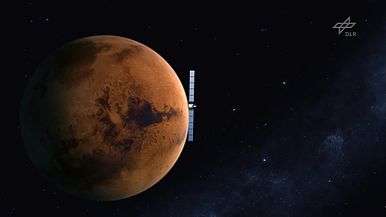
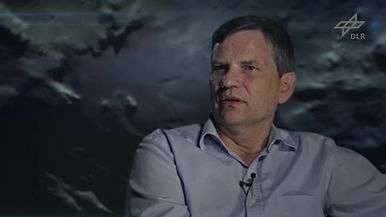
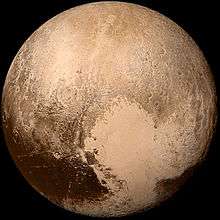
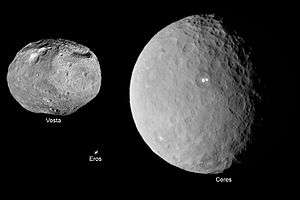


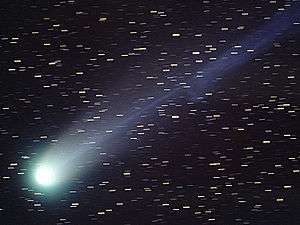

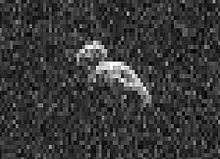
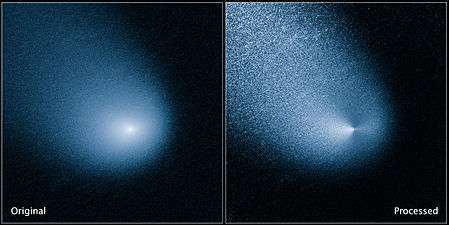
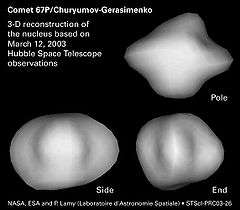

.jpg)
